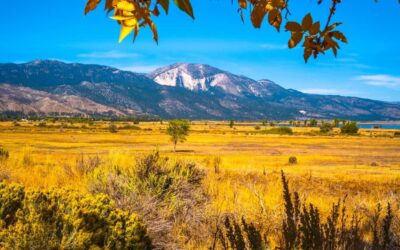Nevada became the 36th state On October 31, 1864, just prior to the presidential election of November 8. It achieved statehood when its Constitution was sent by telegraph to Congress.
This election day was seen as the most significant in American history up to that moment, and the transfer of the Constitution was regarded as critical in assuring that Nevada could vote.
The statehood of West Virginia was rushed through to ensure three electoral votes for Abraham Lincoln’s reelection and increase Republican legislative majorities. This hasty process led to many problems, including that several counties were entirely left out of the new state.
Nevada was the second state admitted to the Union during the Civil War. The first state to be admitted during the Civil War was West Virginia. Nevada was nicknamed the “Battle Born State” because it became a state during the Civil War.
A little History
Who was Reno Nevada named after?
The Shoshone, Paiute, and Washoe tribes were the first inhabitants of the present state. They were Native Americans who lived in the region before European contact. The first European country to explore the region was Spain.
Because of the continuous snowfall that blanketed the mountains during winter, the area was named Nevada, which means “snowy” in Spanish. The land used to be part of the Viceroyalty of New Spain but became a part of Mexico after it gained independence from Spain in 1821.
The United States won the Mexican-American War in 1848 and subsequently annexed the territory as part of the Utah Territory in 1850. The annexation of this territory allowed the United States to expand its borders and gain more control over North America.
The discovery of silver at the Comstock Lode in 1859 profoundly impacted the region. A population boom ensued, which fueled the establishment of Nevada Territory from western Utah Territory in 1861. This event changed the course of history for the area and shaped it into what it is today.
The climate in Nevada is harsh, yet it is also immensely rich. This has had various effects on the state’s history and culture. For example, small Mormon villages near the Utah border have done fairly well, largely thanks to their religion. However, all changed in 1858 when Mormons were forced to flee the area due to persecution. Consequently, the state has a much more diverse population now.
The secular western section of the United States struggled until the major silver strikes began in 1858. These strikes created boom towns and fantastic fortunes for those involved. The increase in silver production led to a surge in the western economy, which had previously lagged behind the country’s eastern portion.
After the turn of the century, profits fell as Progressive reformers sought to rein in galloping capitalism and its concomitant sufferings. They envisioned a civilized Nevada filled with universities, lofty ideals, and social reform. However, their plans were largely unsuccessful, and the state remained largely populated by miners and other workers seeking to make their fortune.
However, by 1920, Nevada had degraded into a “beautiful desert of buried hopes” due to an economic slump in the 1910s, disappointment with failed social reforms, and a population decline of nearly one-fourth. The once-thriving state was now littered with abandoned mines and ghost villages.
Nevada has historically had a boom-and-bust economy that was primarily boom until the global financial crisis of 2008 revealed massive speculation in property and casinos. This is due largely to the state’s excellent transportation infrastructure, simple divorce rules, and speculative get-rich-quick mentality.
1900 – 1950
Between 1900 and 1910, many silver and gold mining camps began to pop up all over the state of Nevada. While most of these camps eventually failed, a few, such as Tonopah, Goldfield, and Jarbidge, were quite successful. These towns proved so profitable that they continue to play an important role in Nevada’s history.
The first neon sign was installed in Nevada at the Oasis Restaurant in Las Vegas in 1927, and it wasn’t long before millions more of these buzzing signs followed suit, establishing the state as the neon capital of the world.
In 1869, gambling was authorized, but it was banned in 1919. It wasn’t until 1931 that gambling became legal again. That same year, the first casino, the Pair-O-Dice Club, opened on what would eventually become the Las Vegas Strip.
In 1935, the enormous Lake Mead was completed. A year later, the equally gigantic Hoover Dam was completed ahead of schedule in 1936. Together, these two projects provided hydroelectric power to power the Las Vegas Strip and most of the American Southwest.
In 1937, Nevada the 36th state officially adopted the slogan “Battle Born.” This slogan reflects the state’s history as a place where many battles have been fought. It also represents the strength and resilience of the people of Nevada.
On the verge of the Cold War, Nevada made history in 1951 when the federal government established the corporate town of Mercury north of Las Vegas. The government hired thousands of workers to protect national security at the Nevada Test Site. Between 1951 and 1992, 928 nuclear tests were conducted in and around Frenchman Flat. These tests included above-ground and below-ground explosions, with hundreds of total detonations. This government land was originally used to conduct nuclear tests. The land is now known as the Nevada National Security Site and is still utilized to conduct national-level experiments to preserve national security. The Nevada National Security Site provides an important service to the United States government and its citizens.
1952 Showgirls became the unofficial symbol of Las Vegas, with each resort on the Strip presenting its particular nightly entertainment. The showgirls represent the ultimate Sin City fantasy and have become an integral part of what makes Las Vegas so unique and alluring.
Situated in the city’s heart, the Washoe County Courthouse was originally built in 1876. Its neoclassical architecture and tall pillars make it an imposing sight. The courthouse became a hub of activity in the mid-1950s when Reno became known as the “Divorce Capital of the World.” This was due to Nevada’s lax divorce rules, which allowed couples to get divorced relatively quickly and easily. Reno constructed housing and entertainment just a step away from the courthouse to take advantage of this, attracting a type of tourist the state had never seen before.
Reno’s courthouse pillars were quickly stained with lipstick as newly liberated women divorced, kissed the courthouse pillars in gratitude, and ceremoniously tossed their wedding rings in the Truckee River. The kisses left behind vibrant hues of pink, orange, and crimson that signified the end of their marriages.
Final Words
Nevada has a long and interesting history. From the early days of the American frontier to the present, Nevada has been where people come to seek their fortune or just have fun. Today, Nevada is best known for its large cities, Las Vegas and Reno, popular tourist destinations worldwide.




